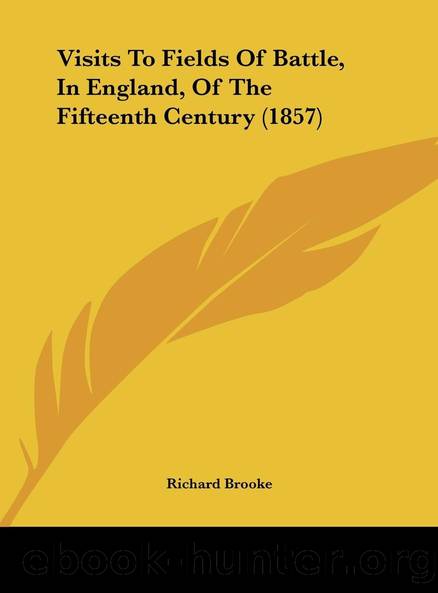Visits to Fields of Battle, in England, of the Fifteenth Century by Richard Brooke

Author:Richard Brooke [Brooke, Richard]
Language: eng
Format: epub
ISBN: 9781355144694
Google: hC_1jwEACAAJ
Goodreads: 30558640
Publisher: BiblioBazaar
Published: 2016-05-02T18:32:54+00:00
CHAPTER XIII.
HANDFORD HALL
AND
CHEADLE CHURCH,
CHESHIRE. [267a]
Handford is a township of the parish of Cheadle, in Cheshire, in the hundred of Macclesfield, intersected by the London and North Western (formerly the Manchester and Birmingham) Railway, and situated eleven miles from Manchester, and five miles south-west-by-south from Stockport.
The village of Handford is agreeably situated in a pleasant part of Cheshire, upon the turnpike-road leading from Manchester to Wilmslow and Congleton. On entering the village from the northward, a neat but small country church, of brick, which is a chapel-of-ease under Cheadle, lying on the left side of the road, and a well-built National School, on the right, are conspicuous objects.
The Village Green is noticed by Sir William Brereton, Bart., of Handford, whose family I shall soon have occasion to advert to, and whose travels in Holland, England, &c. &c., in 1634 and 1635, have been published by the Cheetham Society, in vol. i. of the Cheetham Papers. He refers to the Village Green, [268a] when narrating his travels in Scotland, and in describing one of the places of public entertainment, he calls it âa poorer house than any upon Handforth Green;â and again [268b] he afterwards states that he had been in a small tavern in Ireland, âa little low thatched Irish house, not to be compared unto Jane Kelsallâs, of the Green at Handforth.â [268c] Her cottage has disappeared, and the Green has long been enclosed: no appearance of either of them now remains, and it may be a question whether portions of the railway and its station do not stand on what was once the south-eastern end of the Green; it is, however, to a certain degree, preserved from oblivion, by the field enclosed from its site, being still called the Green Field.
Handford is also sometimes known by the names of Hanford, Honford, Handforth, Handford-cum-Bosden, and Handforth-cum-Bosden (Handford being a joint township with the township of Bosden). Some centuries ago the manor and estate of Handford belonged to the ancient family of Handford of Handford; then, by marriage, to that of Brereton, in the reign of Elizabeth; [268d] they afterwards passed, under a deed of settlement, to that of Booth, Sir William Brereton having, in the reign of Charles II., settled them, in default of male issue of his son, on Nathaniel Booth, Esq., of Mottram St. Andrew, in tail male; but the estate did not remain any considerable time with the Booths, and it soon became subdivided amongst various proprietors. The manorial rights, however, remained a much longer period with the Booths; the manor having been sold and conveyed, in 1766, by Nathaniel, Baron Delamer, formerly Nathaniel Booth, Esq., and others, to Edward Wrench, Esq., of Chester; in 1805, it was again sold, to Mr. Joseph Cooper, of Handford; and, in 1808, it was once more sold, by the devisees in trust under his will, to Mr. William Pass, of Altrincham.
The family of Brereton, and also those of Grosvenor and Davenport, are mentioned by Ormerod, in his History of Cheshire,
Download
This site does not store any files on its server. We only index and link to content provided by other sites. Please contact the content providers to delete copyright contents if any and email us, we'll remove relevant links or contents immediately.
Harry Potter and the Goblet Of Fire by J.K. Rowling(3025)
Unfinished: A Memoir by Priyanka Chopra Jonas(2911)
Never by Ken Follett(2873)
The Man Who Died Twice by Richard Osman(2290)
Machine Learning at Scale with H2O by Gregory Keys | David Whiting(2267)
Fairy Tale by Stephen King(2058)
Will by Will Smith(2033)
Rationality by Steven Pinker(1761)
The Storyteller by Dave Grohl(1656)
The Dawn of Everything: A New History of Humanity by David Graeber & David Wengrow(1564)
The Dark Hours by Michael Connelly(1562)
The Stranger in the Lifeboat by Mitch Albom(1529)
Cloud Cuckoo Land by Anthony Doerr(1428)
Friends, Lovers, and the Big Terrible Thing by Matthew Perry(1324)
The Becoming by Nora Roberts(1323)
Einstein: His Life and Universe by Walter Isaacson(1312)
Crying in H Mart by Michelle Zauner(1312)
New Morning Mercies: A Daily Gospel Devotional by Paul David Tripp(1301)
A Short History of War by Jeremy Black(1295)
